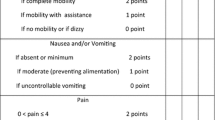Abstract
The objective of this study was to assess the efficacy of perianal infiltration of ropivacaine and dexmedetomidine added to ropivacainein in the relief of pain after hemorrhoidectomy. Patients in group C(placebo control group, n = 21) received perianal injections of normal saline and those in group RO(ropivacaine injection group, n = 21) received ropivacaine, those in group RD(ropivacaine with dexmedetomidine injection group, n = 19) were administered ropivacaine with dexmedetomidine, prior to the initiation of the operation. Reductions of the VAS score, the frequency with which the PCA button was pushed, and fentanyl consumption were assessed in groups RO and RD as compared to that of group C, and in group RD as compared to that of group RO(p < 0.05). We concluded that the use of perianal ropivacaine injection prior to surgical incision reduced both postoperative pain and fentanyl consumption following hemorrhoidectomy, and the addition of dexmedetomidine to ropivacaine may have an additive effect in postoperative analgesic care.




Similar content being viewed by others
References
Holzheimer RG (2004) Hemorrhoidectomy: indications and risks. Eur J Med Res 9:18–36
Nisar PJ, Scholefield JH (2003) Managing haemorrhoids. BMJ 327:847–851
Kehlet H, Rung GW, Callesen T (1998) Postoperative opioid analgesia: time for a reconsideration? J Clin Anesth 8:441–445
Cheetham MJ, Phillips RK (2001) Evidence-based practice in haemorrhoidectomy. Color Dis 3:126–134
Morisaki H, Masuda J, Fukushima K, Iwao Y, Suzuki K, Matsushima M (1996) Wound infiltration with lidocaine prolongs postoperative analgesia after haemorrhoidectomy with spinal anaesthesia. Can J Anaesth 43:914–918
Vinson-Bonnet B, Coltat JC, Fingerhut A, Bonnet F (2002) Local infiltration with ropivacaine improves immediate postoperative pain control after hemorrhoidal surgery. Dis Colon Rectum 45:104–108
Brunat G, Pouzeratte Y, Mann C, Didelot JM, Rochon JC, Eledjam J (2003) Posterior perineal block with ropivacaine 0.75 % for pain control during and after hemorrhoidectomy. Reg Anesth Pain Med 28:228–232
Brummett CM, Padda AK, Amodeo FS, Welch KB, Lydic R (2009) Perineural dexmedetomidine added to ropivacaine causes a dose-dependent increase in the duration of thermal antinociception in sciatic nerve block in rat. Anesthesiology 111:1111–1119
Weinbroum AA, Ben-Abraham R (2001) Dextromethorphan and dexmedetomidine: new agents for the control of perioperative pain. Eur J Surg 167:563–569
Elcicek K, Tekin M, Kati I (2010) The effects of intravenous dexmedetomidine on spinal hyperbaric ropivacaine anesthesia. J Anesth 24:544–548
Hollmann MW, Gross A, Jelacin N (2001) Local anesthetic effects on priming and activation of human neutrophils. Anesthesiology 95:113–122
Woolf CJ, Chong MS (1993) Preemptive analgesia—treating postoperative pain by preventing the establishment of central sensitization. Anesth Analg 77:362–379
Hussein MK, Taha AM, Haddad FF (1998) Bupivacaine local injection in anorectal surgery. Int Surg 83:56–57
Scott DB, Lee A, Fagan D (1989) Acute toxicity of ropivacaine compared with that of bupivacaine. Anesth Analg 69:563–569
Santos AC, Arthur GR, Wlody D, De Armas P, Morishima HO, Finster M (1995) Comparative systemic toxicity of ropivacaine and bupivacaine in nonpregnant and pregnant ewes. Anesthesiology 82:734–740, discussion 727A
Cederholm I, Evers H, Lofstrom JB (1992) Skin blood flow after intradermal injection of ropivacaine in various concentrations with and without epinephrine evaluated by laser Doppler flowmetry. Reg Anesth 17:322–328
Ramsay MA, Luterman DL (2004) Dexmedetomidine as a total intravenous anesthetic agent. Anesthesiology 101:787–790
Memis D, Turan A, Karamanlioglu B, Pamukcu Z, Kurt I (2004) Adding dexmedetomidine to lidocaine for intravenous regional anesthesia. Anesth Analg 98:835–840
Coskuner I, Tekin M, Kati I, Yagmur C, Elcicek K (2007) Effects of dexmedetomidine on the duration of anaesthesia and wakefulness in bupivacaine epidural block. Eur J Anaesthesiol 24:535–540
Kaya FN, Yavascaoglu B, Turker G, Yildirim A, Gurbet A, Mogol EB, Ozcan B (2010) Intravenous dexmedetomidine, but not midazolam, prolongs bupivacaine spinal anesthesia. Can J Anaesth 57:39–45
Ebert TJ, Hall JE, Barney JA, Uhrich TD, Colinco MD (2000) The effects of increasing plasma concentrations of dexmedetomidine in humans. Anesthesiology 93:382–394
Choyce A, Peng P (2002) A systematic review of adjuncts for intravenous regional anesthesia for surgical procedures. Can J Anaesth 49:32–45
Acknowledgments
This research was supported by Basic Science Research Program through the National Research Foundation of Korea(NRF) funded by the Ministry of Education, Science and Technology (2012R1A1A1003700).
Author information
Authors and Affiliations
Corresponding author
Rights and permissions
About this article
Cite this article
Kim, B.G., Kang, H. The Effect of Preemptive Perianal Ropivacaine and Ropivacaine with Dexmedetomidine on Pain after Hemorrhoidectomy: A Prospective, Randomized, Double-Blind, Placebo-Controlled Study. Indian J Surg 76, 49–55 (2014). https://doi.org/10.1007/s12262-012-0622-5
Received:
Accepted:
Published:
Issue Date:
DOI: https://doi.org/10.1007/s12262-012-0622-5




